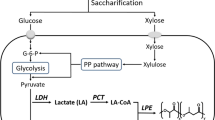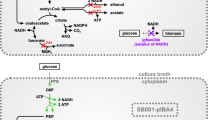Abstract
Nine anaerobic promoters were cloned and constructed upstream of PHB synthesis genes phbCAB from Ralstonia eutropha for the micro- or anaerobic PHB production in recombinant Escherichia coli. Among the promoters, the one for alcohol dehydrogenase (PadhE) was found most effective. Recombinant E. coli JM 109 (pWCY09) harboring PadhE and phbCAB achieved a 48% PHB accumulation in the cell dry weight after 48 h of static culture compared with only 30% PHB production under its native promoter. Sixty-seven percent PHB was produced in the dry weight (CDW) of an acetate pathway deleted (Δpta deletion) E. coli JW2294 harboring the vector pWCY09. In a batch process conducted in a 5.5-l NBS fermentor containing 3 l glucose LB medium, E. coli JW2294 (pWCY09) grew to 7.8 g/l CDW containing 64% PHB after 24 h of microaerobic incubation. In addition, molecular weight of PHB was observed to be much higher under microaerobic culture conditions. The high activity of PadhE appeared to be the reason for improved micro- or anaerobic cell growth and PHB production while high molecular weight contributed to the static culture condition.


Similar content being viewed by others
References
Agus J, Kahar P, Abe H, Doi Y, Tsuge T (2006a) Altered expression of polyhydroxyalkanoate synthase gene and its effect on poly[(R)-3-hydroxybutyrate] synthesis in recombinant Escherichia coli. Polym Degrad Stab 91:1645–1650
Agus J, Kahar P, Abe H, Doi Y, Tsuge T (2006b) Molecular weight characterization of poly[(R)-3-hydroxybutyrate] synthesized by genetically engineered strains of Escherichia coli. Polym Degrad Stab 91:1138–1146
Ahn WS, Park SJ, Lee SY (2000) Production of Poly(3-hydroxybutyrate) by fed-batch culture of recombinant Escherichia coli with a highly concentrated whey solution. Appl Environ Microbiol 66:3624–3627
Anderson AJ, Dawes EA (1990) Occurrence, metabolism, metabolic role, and industrial uses of bacterial polyhydroxyalkanoates. Microbiol Rev 54:450–472
Antonio RV, Steinbüchel A, Rehm BH (2000) Analysis of in vivo substrate specificity of the PHA synthase from Ralstonia eutropha: formation of novel copolyesters in recombinant Escherichia coli. FEMS Microbiol Lett 182:111–117
Aoki T, Satoh K, Imamura T, Watabe H (2004) A new method for detecting single nucleotide polymorphism using GFP-display. J Biochem Biophys Meth 60:61–67
Baba T, Ara T, Hasegawa M, Takai Y, Okumura Y, Baba M, Datsenko KA, Tomita M, Wanner BL, Mori H (2006) Construction of Escherichia coli K-12 in-frame, single-gene knockout mutants: the Keio collection. Mol Syst Biol 2:0008
Bergthorsson U, Ochman H (1995) Heterogeneity of genome sizes among natural isolates of Escherichia coli. J Bacteriol 177:5784–5789
Brandl H, Gross RA, Lenz RW, Fuller RC (1988) Pseudomonas oleovorans as a source of poly(beta-hydroxyalkanoates) for potential applications as biodegradable polyesters. Appl Environ Microbiol 54:1977–1982
Byrom D (1992) Production of poly-β-hydroxybutyrate: poly-β-hydroxyvalerate copolymers. FEMS Microbiol Rev 103:247–250
Carlson R, Wlaschin A, Srienc F (2005) Kinetic studies and biochemical pathway analysis of anaerobic poly-(R)-3-hydroxybutyric acid synthesis in Escherichia coli. Appl Environ Microbiol 71:713–720
Chang DE, Shin S, Rhee JS, Pan JG (1999) Acetate metabolism in a pta mutant of Escherichia coli W3110: importance of maintaining acetyl coenzyme a flux for growth and survival. J Bacteriol 181:6656–6663
Chen GQ (2002) Production and application of microbial polyhydroxyalkanoates. Kluwer/Plenum, New York, pp 155–166.
Chen YM, Lin EC (1991) Regulation of the adhE gene, which encodes ethanol dehydrogenase in Escherichia coli. J Bacteriol 173:8009–8013
Chen GQ, Page WJ (1997) Production of poly-beta-hydroxybutyrate by Azotobacter vinelandii in a two-stage fermentation process. Biotechnol Tech 11:347–350
Chen GQ, Wu Q (2005) The application of polyhydroxyalkanoates as tissue engineering materials. Biomaterials 26:6565–6578
Chen GQ, Konig KH, Lafferty RM (1991) Production of poly-D(−)-3-hydroxybutyrate and poly-D(−)-3-hydroxyvalerate by strains of Alcaligenes latus. Antonie Van Leeuwenhoek 60:61–66
Chen GQ, Zhang G, Park SJ, Lee SY (2001) Industrial scale production of poly(3-hydroxybutyrate-co-3-hydroxyhexanoate). Appl Microbiol Biotechnol 57:50–55
Choi JI, Lee SY (2004) High level production of supra molecular weight poly(3-hydroxybutyrate) by metabolically engineered Escherichia coli. Biotechnol Bioprocess Eng 9:196–200
Choi JI, Lee SY, Han K (1998) Cloning of the Alcaligenes latus polyhydroxyalkanoate biosynthesis genes and use of these genes for enhanced production of Poly(3-hydroxybutyrate) in Escherichia coli. Appl Environ Microbiol 64:4897–4903
Compan I, Touati D (1994) Anaerobic activation of arcA transcription in Escherichia coli: roles of Fnr and ArcA. Mol Microbiol 11:955–964
Datsenko KA, Wanner BL (2000) One-step inactivation of chromosomal genes in Escherichia coli K-12 using PCR products. Proc Natl Acad Sci U S A 97:6640–6645
Dawes EA, Senior PJ (1973) The role and regulation of energy reserve polymers in micro-organisms. Adv Microb Physiol 10:135–266
de Graef MR, Alexeeva S, Snoep JL, Teixeira de Mattos MJ (1999) The steady-state internal redox state (NADH/NAD) reflects the external redox state and is correlated with catabolic adaptation in Escherichia coli. J Bacteriol 181:2351–2357
Goodlove PE, Cunningham PR, Parker J, Clark DP (1989) Cloning and sequence analysis of the fermentative alcohol-dehydrogenase-encoding gene of Escherichia coli. Gene 85:209–214
Griffith KL, Wolf RE (2002) Measuring beta-galactosidase activity in bacteria: cell growth, permeabilization, and enzyme assays in 96-well arrays. Biochem Biophys Res Commun 290:397–402
Harding KG, Dennis JS, von Blottnitz H, Harrison ST (2007) Environmental analysis of plastic production processes: comparing petroleum-based polypropylene and polyethylene with biologically-based poly-beta-hydroxybutyric acid using life cycle analysis. J Biotechnol 130:57–66
Hartmann R, Hany R, Pletscher E, Ritter A, Witholt B, Zinn M (2006) Tailor-made olefinic medium-chain-length poly[(R)-3-hydroxyalkanoates] by Pseudomonas putida GPo1: batch versus chemostat production. Biotechnol Bioeng 93:737–746
Hong K, Leung YC, Kwok SY, Law KH, Lo WH, Chua H, Yu PH (2000) Construction of recombinant Escherichia coli strains for polyhydroxybutyrate production using soy waste as nutrient. Appl Biochem Biotechnol 84–86:381–390
Kakuda H, Shiroishi K, Hosono K, Ichihara S (1994) Construction of Pta–Ack pathway deletion mutants of Escherichia coli and characteristic growth profiles of the mutants in a rich medium. Biosci, Biotechnol, Biochem 58:2232–2235
Kusaka S, Abe H, Lee SY, Doi Y (1997) Molecular mass of poly[(R)-3-hydroxybutyric acid] produced in a recombinant Escherichia coli. Appl Microbiol Biotechnol 47:140–143
Lee SH, Oh DH, Ahn WS, Lee Y, Choi J, Lee SY (2000) Production of poly (3-hydroxybutyrate-co-3-hydroxyhexanoate) by high-cell-density cultivation of Aeromonas hydrophila. Biotechnol Bioeng 67:240–244
Lemoigne M (1926) Produits de deshydration et depolymerisation de l’acide β-oxybytyrique. Bull Soc Chim Biol (Paris) 8:770–782
Leonardo MR, Cunningham PR, Clark DP (1993) Anaerobic regulation of the adhE gene, encoding the fermentative alcohol dehydrogenase of Escherichia coli. J Bacteriol 175:870–878
Lin EC, Iuchi S (1991) Regulation of gene expression in fermentative and respiratory systems in Escherichia coli and related bacteria. Annu Rev Genet 25:361–387
Manna A, Paul AK (2003) Growth-associated production and characterization of poly (3-hydroxybutyric acid) of Azotobacter beijerinckii DAR-102. Indian J Exp Biol 41:129–134
Membrillo-Hernandez J, Kwon O, De Wulf P, Finkel SE, Lin ECC (1999) Regulation of adhE (encoding ethanol oxidoreductase) by the Fis protein in Escherichia coli. J Bacteriol 181:7390–7393
Mikulskis A, Aristarkhov A, Lin EC (1997) Regulation of expression of the ethanol dehydrogenase gene (adhE) in Escherichia coli by catabolite repressor activator protein Cra. J Bacteriol 179:7129–7134
Miyake M, Miyamoto C (2000) Phosphotransacetylase as a key factor in biological production of polyhydroxybutyrate. Appl Biochem Biotechnol 84–6:1039–1044
Nikel PI, Pettinari MJ, Galvagno MA, Mendez BS (2006) Poly(3-hydroxybutyrate) synthesis by recombinant Escherichia coli arcA mutants in microaerobiosis. Appl Environ Microbiol 72:2614–2620
Nikel PI, Pettinari MJ, Galvagno MA, Mendez BS (2008) Poly(3-hydroxybutyrate) synthesis from glycerol by a recombinant Escherichia coli arcA mutant in fed-batch microaerobic cultures. Appl Microbiol Biotechnol 77:1337–1343
Nordkvist M, Jensen NBS, Villadsen J (2003) Glucose metabolism in Lactococcus lactis MG1363 under different aeration conditions: requirement of acetate to sustain growth under microaerobic conditions. Appl Environ Microbiol 69:3462–3468
Normi YM, Hiraishi T, Taguchi S, Sudesh K, Najimudin N, Doi Y (2005) Site-directed saturation mutagenesis at residue F420 and recombination with another beneficial mutation of Ralstonia eutropha polyhydroxyalkanoate synthase. Biotechnol Lett 27:705–712
Pettinari MJ, Vazquez GJ, Silberschmidt D, Rehm B, Steinbüchel A, Mendez BS (2001) Poly(3-hydroxybutyrate) synthesis genes in Azotobacter sp. strain FA8. Appl Environ Microbiol 67(11):5331–5334
Poirier Y, Nawrath C, Somerville C (1995) Production of polyhydroxyalkanoates, a family of biodegradable plastics and elastomers, in bacteria and plants. Bio-Technol 13:142–150
Quillaguaman J, Munoz M, Mattiasson B, Hatti-Kaul R (2007) Optimizing conditions for poly(beta-hydroxybutyrate) production by Halomonas boliviensis LC1 in batch culture with sucrose as carbon source. Appl Microbiol Biotechnol 74:981–986
Rhu DH, Lee WH, Kim JY, Choi E (2003) Polyhydroxyalkanoate (PHA) production from waste. Water Sci Technol 48:221–228
Sabra W, Kim EJ, Zeng AP (2002) Physiological responses of Pseudomonas aeruginosa PAO1 to oxidative stress in controlled microaerobic and aerobic cultures. Microbiology-SGM 148:3195–3202
Sambrook J, Russell DW (2001) Molecular cloning: a laboratory manual, 3rd edn. Cold Spring Harbor Laboratory Press, Cold Spring Harbor
Santos PM, Di Bartolo I, Blatny JM, Zennaro E, Valla S (2001) New broad-host-range promoter probe vectors based on the plasmid RK2 replicon. FEMS Microbiol Lett 195:91–96
Shi H, Nikawa J, Shimizu K (1999) Effect of modifying metabolic network on poly-3-hydroxybutyrate biosynthesis in recombinant Escherichia coli. J Biosci Bioeng 87:666–677
Sim SJ, Snell KD, Hogan SA, Stubbe J, Rha CK, Sinskey AJ (1997) PHA synthase activity controls the molecular weight and polydispersity of polyhydroxybutyrate in vivo. Nat Biotechnol 15:63–67
Singh R, Yang YT, Lu BQ, Bennett GN, San KY (2006) Expression of the pfl gene and resulting metabolite flux distribution in nuo and ackA-pta E. coli mutant strains. Biotechnol Prog 22:898–902
Slater SC, Voige WH, Dennis DE (1988) Cloning and expression in Escherichia coli of the Alcaligenes eutrophus H16 poly-beta-hydroxybutyrate biosynthetic pathway. J Bacteriol 170:4431–4436
Spiekermann P, Rehm BH, Kalscheuer R, Baumeister D, Steinbuchel A (1999) A sensitive, viable-colony staining method using Nile red for direct screening of bacteria that accumulate polyhydroxyalkanoic acids and other lipid storage compounds. Arch Microbiol 171:73–80
Spiro S, Guest JR (1991) Adaptive responses to oxygen limitation in Escherichia coli. Trends Biochem Sci 16:310–314
Tsai PS, Nageli M, Bailey JE (1996) Intracellular expression of Vitreoscilla hemoglobin modifies microaerobic Escherichia coli metabolism through elevated concentration and specific activity of cytochrome o. Biotechnol Bioeng 49:151–160
Wong HH, Lee SY (1998) Poly-(3-hydroxybutyrate) production from whey by high-density cultivation of recombinant Escherichia coli. Appl Microbiol Biotechnol 50:30–33
Zeng AP, Deckwer WD (1996) Bioreaction techniques under microaerobic conditions: from molecular level to pilot plant reactors. Chem Eng Sci 51:2305–2314
Acknowledgment
We are grateful to Professor Alexander Steinbüchel of the University of Münster in Germany for the generous donation of plasmid pBHR68 and to Keio collection, Japan, for kindly providing us with E. coli mutant strains. This research was supported by Natural Sciences Foundation of China Grant No. 30570024. Thanks must also be extended to National High Tech 863 Grant (Project Nos. 2006AA02Z242 and 2006AA020104), and National Basic Research Program of China (973 Program) No. 2007CB707804.
Author information
Authors and Affiliations
Corresponding author
Rights and permissions
About this article
Cite this article
Wei, XX., Shi, ZY., Yuan, MQ. et al. Effect of anaerobic promoters on the microaerobic production of polyhydroxybutyrate (PHB) in recombinant Escherichia coli . Appl Microbiol Biotechnol 82, 703–712 (2009). https://doi.org/10.1007/s00253-008-1816-4
Received:
Revised:
Accepted:
Published:
Issue Date:
DOI: https://doi.org/10.1007/s00253-008-1816-4




